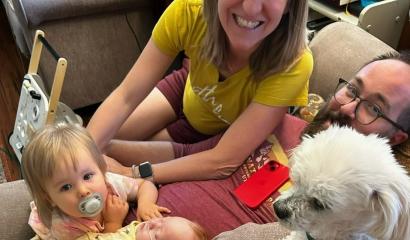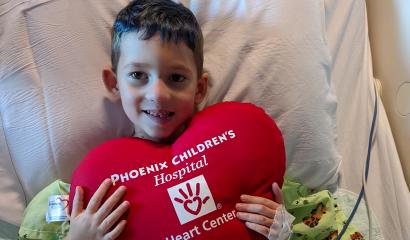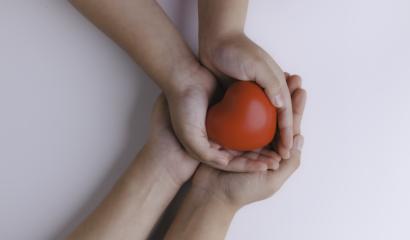Bright Futures
Articles and Updates from Phoenix Children's
One Baby’s Legacy
Each morning before heading to work, Rachel listens to her baby girl’s heartbeat – a treasured memory of her firstborn.
Emerson, diagnosed in the womb with a complex congenital heart defect, survived for just over two hours after her birth in September 2021. But the family – including Emerson’s twin sister, Oaklyn – stays forever connected with their “angel baby” through the heartbeat recording, preserved in a teddy bear given to the family by the fetal cardiology team at Phoenix Children’s.
“The bear is something that I will cherish and appreciate forever,” Rachel said. “Every day after I get Oaklyn ready and head out for the day, I listen to it before I leave. I’m so happy our family has this little piece of Emerson and that Oaklyn can always listen to her sister’s heartbeat.”
Excitement Turns to Concern
When Rachel and her husband, Tyler, learned they were expecting twins, the couple was over the moon with excitement. But the routine 21-week ultrasound revealed that Emerson had pericardial effusion, or excess fluid around the heart. Assuring Rachel that there was likely nothing to worry about, her OB/GYN referred her to a high-risk maternal-fetal medicine specialist in Phoenix – a three-hour drive away from the family’s home in Kingman.
“They told me, ‘Don’t be surprised if it turns out to be nothing serious,’” Rachel said. “So, I wasn’t too concerned at that point.”
Unfortunately, the family received devastating news two weeks later. While Oaklyn was developing normally, Emerson was diagnosed with hypoplastic left heart syndrome (HLHS). The rare heart defect, which occurs in about 1 in 3,800 births, affects formation of the organ’s left side and hinders normal blood flow through the heart. If the baby survived pregnancy, she would likely need open heart surgery shortly after birth. The maternal-fetal medicine team referred Rachel and Tyler to the Fetal Cardiology Program at Phoenix Children’s for further evaluation.
Unborn Baby’s Condition Declines
At Phoenix Children’s, the twins underwent a fetal echocardiogram (echo) for a closer look at their hearts. Pediatric cardiologist Christopher L. Lindblade, MD, confirmed the HLHS diagnosis, along with mitral stenosis, aortic atresia and intact atrial septum. Though many babies with HLHS survive after surgical intervention, Emerson was labeled as high risk because her condition was so severe.
“We frequently take care of patients with hypoplastic left heart syndrome, and they’re thriving,” said Dr. Lindblade, who also is medical director of the Fetal Cardiology Program. “But the restriction at the atrial septum meant there was limited flow of oxygenated blood returning from the lungs. That leads to damage of the pulmonary arteries, which is associated with a high mortality risk.”
Despite the poor prognosis, Rachel and Tyler continued making the long trip to Phoenix for bi-weekly echos and OB appointments throughout the pregnancy. At 30 weeks’ gestation, Rachel underwent magnetic resonance imaging (MRI). This imaging test revealed that the baby had pulmonary lymphangiectasia (CPL), a condition in which the lungs are severely damaged and filled with fluid.
“Every time we went back to Phoenix Children’s, we ended up getting an extra piece of Emerson’s diagnosis,” Rachel said. “It was really discouraging.”
Facing Heart-Wrenching Choices
Rachel and Tyler had to make a difficult decision: They could choose comfort care for Emerson, spending precious time together as a family before she would pass away. Or they could pursue interventional care for Emerson, meaning the baby would be rushed by ambulance to Phoenix Children’s to undergo open heart surgery immediately after being delivered. This option would mean that Tyler would stay close to Oaklyn, the healthy twin, while Rachel would go to Phoenix Children’s with Emerson. And there was no guarantee that Emerson would even survive surgery.
“We were willing to do whatever was needed for Emerson, but every single time we went back for an appointment, the news kept getting worse and worse,” said Rachel.
The couple’s faith played a strong role in their decisions throughout Rachel’s pregnancy. Before their last appointment at Phoenix Children’s, Rachel and Tyler prayed, as they had all along, for a clear sign of what to do for Emerson. The news about the baby’s condition was even worse that day. They knew the most compassionate choice for her would be comfort care.
“We decided to make her comfortable and embrace whatever time we could have with her,” Rachel said.
Comfort Care over Intervention
While Emerson’s prognosis was bleak, Rachel and Tyler also wanted to consider what was best for Oaklyn, who appeared to be perfectly healthy. Ultimately, they didn’t want their family to be separated or to put Emerson through surgery and other painful interventions when she already was so sick.
Rachel and Tyler worked with the Phoenix Children’s Palliative Care Program during the pregnancy to process their emotions and develop a birth plan that would give Emerson the best quality of life possible – no matter how short her life would be.
“For some families, loving their baby means protecting the newborn from interventions they feel will not help,” said Billie A. Winegard, MD. “We talk to parents about the different options for delivery and after birth, and that gives them a chance to think about what’s most important to them. For example, what degree of care do they want for the baby after birth? Do they prefer allowing the child to pass away with no intervention? Who should be there to meet the baby? What kind of memories do they want to create? Do they want to hold their baby during those last moments of life? Do they want to bathe their baby? Do they want to dress their baby? Our role is to help families think about all their options, so they don't walk away from the experience with regrets. And for each family, the goals and desires are so different across the board.”
Rachel and Tyler wanted to spend every moment possible with Emerson, who was delivered first. After she was born, the delivery team paused Rachel’s labor, allowing the family to spend precious time praying over and cuddling with Emerson before Oaklyn would make her entry into the world about six hours later.
Learning from Emerson
Rachel and Tyler generously donated Emerson’s heart and lungs to Phoenix Children’s pathology for teaching. Dr. Lindblade says the cardiology team, including fellows and other trainees at the hospital, as well as the sonographers who conduct the imaging tests, were able to view the organs, gaining better insight into what these congenital defects look like.
“The family’s willingness to donate these organs is valuable from a learning perspective,” Dr. Lindblade said. “These situations, fortunately, do not happen frequently. But next time we face a similar clinical scenario, our team will have a better understanding of what’s happening. Emerson’s legacy will impact future generations in terms of the care that we are able to provide for other families.”
For Rachel and Tyler, receiving Emerson’s autopsy results brought peace of mind. The medical team determined that Emerson would’ve needed a heart transplant in her first year – had she even survived the multiple surgeries that would’ve been necessary first. But she probably wouldn’t have qualified for a heart transplant because her lungs were also severely damaged.
“When we decided to let Emerson pass away with us instead of going through intensive care, we never questioned whether we made the right choice. But sometimes we wondered if it was selfish not to try to save her,” recalled Rachel. “But Dr. Lindblade told us that it was selfless to let her pass in our arms rather than putting her through the pain of intensive care. I have never had so much lifted off my shoulders after hearing that. I feel so sad that my sweet girl had such a hard fight, but I’m so thankful that she was strong enough to make it to delivery so I could meet her and love her forever.”
![Her [Heart] Beat Lives On](/files/styles/large/public/Emerson4.jpg?itok=NVa6JCez)
![Her [Heart] Beat Lives On](/files/styles/large/public/Emerson2.jpg?itok=jBOhkvrF)
![Her [Heart] Beat Lives On](/files/styles/large/public/Emerson6.jpg?itok=G9YV5Lzh)
![Her [Heart] Beat Lives On](/files/styles/large/public/Emerson16.jpg?itok=sjLS7_WZ)
![Her [Heart] Beat Lives On](/files/styles/large/public/Emerson17.jpg?itok=jNMRFhY8)
![Her [Heart] Beat Lives On](/files/styles/large/public/Emerson7.jpg?itok=PxaADSiX)


